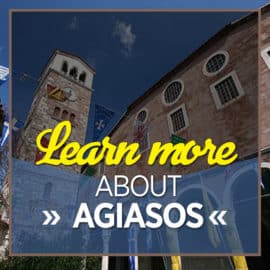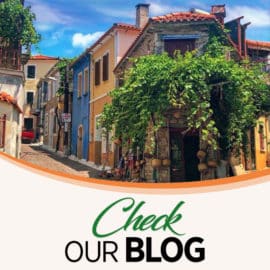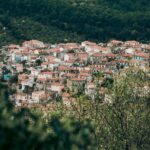Overview
In the center of Agiasos, below the central Market square, you will find one of the most important pilgrimages in Lesvos, the impressive church of the Dormition of the Virgin Mary. It’s history is closely related to the icon of the Virgin Mary that is called “Agia Sion” that was brought by Agathon at 803 BC, from which, through a modification of the name, came the name of the settlement Agiasos.
There is also a museum housed in the monastery’s property that you can visit.
It is said that the icon of Virgin Mary is miraculous, thus it attracts many pilgrims especially on the 15th of August. If you find yourselves in Lesvos these days, you will be impressed by the amount of pilgrims, coming from every corner of the island, Greece or even the word, traveling by foot in order to get to Agiasos.
History
In 1170 the monks of Karya built – with the permission of the then governor of Lesvos Konstantinos Valerios – the church of the Virgin Mary, on the hill where the bones of Agathon were in order to house the image of Virgin Mary holding baby Jesus in Her arms, which is widely believed that is created by Saint Luke and made of mastic and candle. A monk named Agathon, transferred the image from Jerusalem to Agiasos in 803 BC.. The church was completed and inaugurated in 1173. It was preserved for 633 years. A small settlement was formed around the church, which evolved over time into a large and remarkable town. When the island was enslaved to the Turks, many Christians took their families and fled to the Church of Holy Lady to be saved.
However, because the first church was now unstable and dangerous, due to the deterioration of time, in 1806 at the initiative of the then Metropolitan of Mytilene Ieremios and the priests of Agiasos, the temple was demolished and a new, larger one was built even though the Turkish authorities had given order to build the new temple on the exact foundations of the old. The decoration of the temple was as bold as the old one, because the gifts of the Christians were rich. The temple acquired fine works of ecclesiastical woodcarving, such as the iconostasis, the throne, the pulpit, the pilgrimages. By 1783 the Monastery of Agathon had been demolished and the church had become Parish of the Community and Parish of Agiasos.
While the craftsmen were still working on the carvings, suddenly, on the night of August 6, 1812, the temple came in the way of the great fire that burned much of the town. Fortunately, only one icon of the icon of Christ was destroyed, all of the rest were saved.
In the year 1815 with donations, which the Christians of Agiasos offer with enthusiasm, and with the fundraisers of the Metropolitan of Mitilini Kallinikos with his envoys in the province, as well as in the other parts of Asia Minor, a temple (the third in a row) is erected on the previous’ temple foundations which is preserved to this day.
The temple was built with the permission of Sultan Mahmut II, granted at the request of the inhabitants of Agiasos, on the condition that it would not be larger than the old one. The length of the temple is 32.20 m and its width 26.20 m. It is a three-aisled basilica with three niches of the Holy Step, three Holy Banks (of which the right is dedicated to Agios Charalambos and the left to Agios Nikolaos), marble iconostasis and large gyneconite. For many years specialist craftsmen were involved in the construction of the iconostasis, the throne and the pulpit. The offerings of the faithful, the Byzantine and post-Byzantine icons that adorn the temple are a treasure of immense value. The interior decoration of the church was supplemented by a new fund in 1938.
A second fire, in 1877, burned down almost the entire village, but not the church. The houses, which until then were wooden from the middle and above and protruding to the narrow streets, were rebuilt in stone and the streets widened. The village took its present form. In 1971 the Pilgrimage of Our Holy Lady was also recognized by the law as a “Holy Pilgrimage” and has since been governed by a five-member commission. In 1977 the last radical internal pilgrimage renovation took place.
Meanwhile, around 1453, that is, when the city was destroyed by the Turks, the Christians of the temple, seeing that the image of the Virgin Mary began to be decay by the passage of time, commissioned a good hagiographer to make a faithful copy of the old icon to hide the original. The Icon-copy is an excellent work of Byzantine art. In 1838 the original image was found hidden inside the newer icon of the Virgin Mary, in a wooden box and wrapped in a cloth dipped in wax but terribly damaged. The repair of the damage was done with great care by the Russian artisan – a special conservator of the icons of the Byzantine Museum of Athens – Basil Rachtchevski. The old icon has since been placed in a wooden case with double glass in a marble shrine in front of the replica icon of the Virgin Mary at the iconostasis.
Source: “Ο Ιερός Ναός Της Παναγίας Αγιάσου (Κοιμήσεως Θεοτόκου).” Agiasos.gr, 15 Mar. 2019, http://www.agiasos.gr/article/o-ieros-naos-tis-panagias-agiasoy-koimiseos-theotokoy






